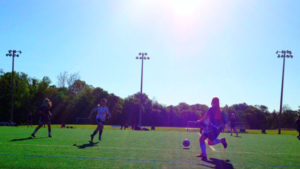Synthetic turf cancer risk tiny compared to more sedentary lifestyle alternative
 It happened again, this time at my high school reunion. A former softball teammate pulled me aside, imploring, “Did you know synthetic turf causes cancer?”
It happened again, this time at my high school reunion. A former softball teammate pulled me aside, imploring, “Did you know synthetic turf causes cancer?”
Then she continued to supply me with evidence that this was the case. Her source: NBC News.
She is the most recent of many people who have come to me with concerns raised about the artificial turf our kids are nearly always playing on these days. Parents have heard the news reports and are alarmed.
+READ: Former CDC toxicologist unsurprised by alleged link between artificial turf, cancer
That is the purpose of news reporting, to draw you in, get you invested and, these days, to get you to share what you hear. In this information age news travels fast; bad news travels faster. And research shows that the more times you hear something the more likely you are to believe it, even if it’s not true. If it’s alarming or sensational or it hits home, you’re more likely to share it, adding fuel to the fire.
As a scientist, I am leery of breaking news reports which are emotionally charged and very one-sided.
I, like you, was barraged by the sharing of the “turf causes cancer” reports. As a scientist, I am leery of breaking news reports which are emotionally charged and very one-sided. I certainly can’t comment on them without knowing more. So I sent an email to a brilliant friend who is a former Director of the Environmental Protection Agency, asking what she knew about this issue. It was the first she had heard of it.
So let’s slow down here. This story began when Amy Griffin, a compassionate soccer coach was visiting two young athletes who were being treated for non-Hodgkin’s lymphoma. The nurse administering their chemotherapy was surprised to find several goalkeepers in her care recently. One young athlete receiving treatment said, “I just have a feeling it has to do with those black dots.”
In response to “a feeling,” people are now calling for the removal of synthetic turf and tearing up turf fields. Yes, rubber, like plastic, like pesticides, like fertilizers, like soft drinks, like additives and preservatives, like innumerable other substances, contain chemicals “known to cause cancer.”
Hey, even the outdoors doesn’t get a pass. The sun causes cancer, after all. That’s why we study and regulate the amount of these substances to “safe levels” determined by scientific studies designed to assess the actual risk.
So wait a minute before you go running wildly into the board meeting yelling, “there are known carcinogens in those fields and that’s not safe for our kids!” Lots of stuff increases the likelihood we will develop cancer. But our fear, egged on by the media, has us in a panic. And not just about turf. Did anyone else see the airline passenger awaiting her flight in a hazmat suit?
+READ: Elon star, FC Bucks product Nicole “Colie” Dennion battles cancer, wins hearts
It’s a bit reminiscent of a few years back when we read that “saccharine causes cancer.” Diet soda devotees everywhere panicked until we found out that saccharine did indeed cause cancer in laboratory rats, but only at very high doses. You would have to consume approximately 10,000 sodas to match the doses that caused cancer in rats.
Thus, the details of the science and accurate knowledge of the risk are essential. No direct link between cancer and turf has been established. But why hasn’t this risk been assessed? Crumb rubber is used in playgrounds and on running tracks across the country as an inexpensive means to cushion falls and landings.
Turns out it has. I am indebted to Tom Serensits, a researcher at Penn State, who shared this quite comprehensive study conducted by the California Office of Environmental Health Hazard Assessment. [+Download full PDF here]
 It assesses the potential risks to children using outdoor playground and track surfaces constructed from recycled waste tires. In the study they evaluated for the release of chemicals that could cause toxicity in children following ingestion or skin contact as well as the ability of crumb rubber to cushion fall-related impacts and the impact on the local environment.
It assesses the potential risks to children using outdoor playground and track surfaces constructed from recycled waste tires. In the study they evaluated for the release of chemicals that could cause toxicity in children following ingestion or skin contact as well as the ability of crumb rubber to cushion fall-related impacts and the impact on the local environment.
Their findings (short version):
One-time ingestion of 10g (a handful?) of the rubber pellets resulted in a slightly increased cancer risk, but this risk was well below the minimal level of 1 x 10-6 (one in one million), generally considered an acceptable cancer risk due to its small magnitude compared to the overall cancer rate (OEHHA, 2006).
Five of the chemicals released by tire shreds during digestion were carcinogens. If the released chemicals were ingested as a onetime event and averaged over a lifetime, the cancer risk would be 3.7 x 10-8 (3.7 in one hundred million) – considerably below the minimal risk level of 1 x 10-6 (one in one million), generally considered an acceptable cancer risk due to its small magnitude compared to the overall cancer rate (OEHHA, 2006).
For one identified PAH (polycyclic aromatic hydrocarbon), chrysene, which is a carcinogen, and assuming ingestion via chronic hand-to-mouth contact, and playground use from 1 through 12 years of age, wipe sampling indicated an increased cancer risk of 2.9 x 10-6 (2.9 in one million). This risk is slightly higher than the minimal risk level of 1 x 10-6 (one in one million), generally considered an acceptable cancer risk due to its small magnitude compared to the overall cancer rate (OEHHA, 2006).
Based on this, the researchers at Penn State, responding to my inquires by email, stopped short of saying that the cancer risk is insignificant. They recommended we “go with the scientific research, and currently there are no scientific studies reporting elevated risks in typical exposure scenarios.” Dr. Serensits was aware that turf safety has been a hot-button issue in the past week or two. “Hopefully,” he emailed, “a benefit will be an increased interest in scientific research related to both natural and synthetic turf.”
Because the risk of not playing means more sitting at home watching TV or screen-surfing.
And there’s the kicker. Every choice we make comes with a comparative risk. Do I fly or drive? Do I spend or save? Do I invest or withhold? Do I accept the job or not? Go to this school or that one? Play for this team or that? Turf or natural grass? Play or not play? So. Many. Decisions. We’re always playing the odds.
As a soccer nation, we have chosen to invest in these synthetic surfaces because they cushion, they give a reliable bounce and they wear well, so they can tolerate more play under all weather conditions. Tournaments use the percentage of games played on turf as a selling point, so teams know they won’t travel long distances only to see games shortened or canceled. Plus, turf allows kids to play more games and coaches to hold more practices.
+READ: LeBolt: Julie Foudy offers an alternative for our childrens’ soccer development
This means our kids are more active, and that is a VERY good thing. Because the risk of not playing means more sitting at home watching TV or screen-surfing. With those come overweight, obesity, diabetes, heart disease, stroke, arthritis, other joint ailments, just to name a few. In short, I say the benefit to spending more time in the game far surpasses the risk.
Now, we live in reality. Where there is risk, of course we must minimize it.
- We don’t let our small ones build turf mounds out of turf pellets.
- We dump the stuff out of shoes, bags, cars and clothing.
- We avoid getting it in our mouths, and spit it out if we do.
- We shower after playing.
- We use caution about our exposure, perhaps limiting time on turf.
But let’s admit that there is risk every time we take the field (injury), trek through the woods (bears, deer ticks and Lyme), play Frisbee on the beach (skin cancer) or jump the waves (shark attack). We could stay inside and keep to ourselves all day every day, but that’s a risk I am not willing to take.
But please, can we be smart about this stuff? News media often isn’t balanced. It gathers information, leaning toward that which supports its story, and then presents it in a compelling, if sometimes lopsided, way. A quick scoop is the Holy Grail.
+READ: Women’s World Cup TurfGate: FIFA, listen up!
Science, on the other hand, doesn’t rush. It studies, quantifies and applies statistical analysis so that conclusions are based on actual factors rather than random chance.
So, did synthetic turf cause the cancer in these young athletes? I can’t say for sure. If this speculation raises awareness, then good enough. Let’s be smart about these turf pellets, or as my young friend Emily calls them, turf turds.
In fact, maybe that is a good way to think of them. Keep ‘em out of your mouth, out of your stuff and get ‘em off your body as soon as possible. But let’s think twice about the consequences of tossing our turf fields when so much good happens out there on them.
SOCCERWIRE MARKETPLACE
- visitRaleigh.com Showcase Series 2025, hosted by NCFC Youth
- OFFICIAL MANCHESTER CITY SOCCER CAMPS
- Wanted Licensed Youth Soccer Coach
- Join Official Elite Summer Soccer Camps with Europe’s Top Pro Clubs!
- The St. James FC Travel Staff Coach - North (Loudoun) & South (Fairfax)
- The St. James FC Girls Academy (GA) Head Coach - 2 teams
- The St James FC Boys Travel Tryouts
- OFFICIAL BAYERN MUNICH SUMMER CAMPS U.S.
- JOIN THE ALLIANCE!
- OFFICIAL FC BARCELONA CAMPS U.S.











